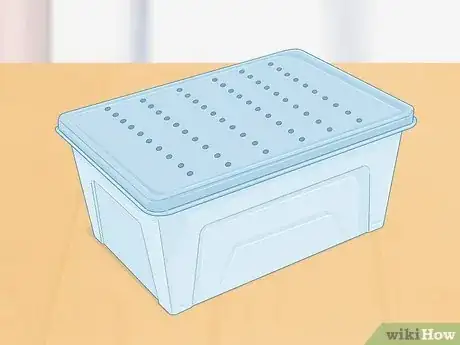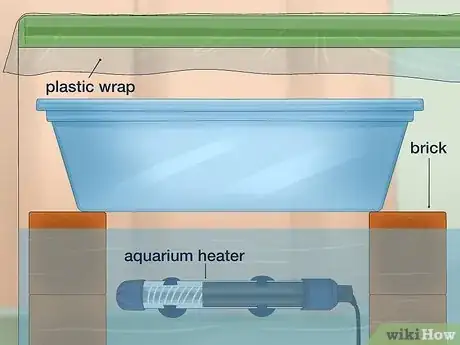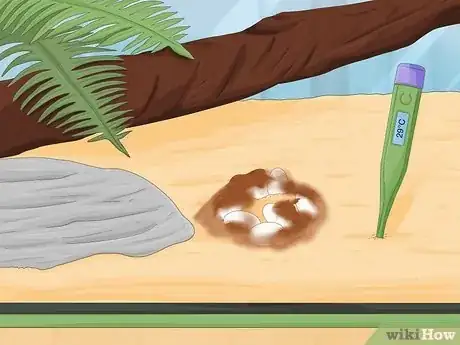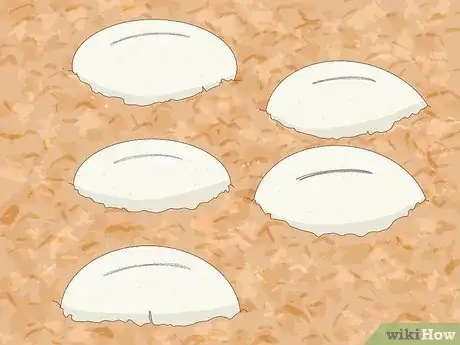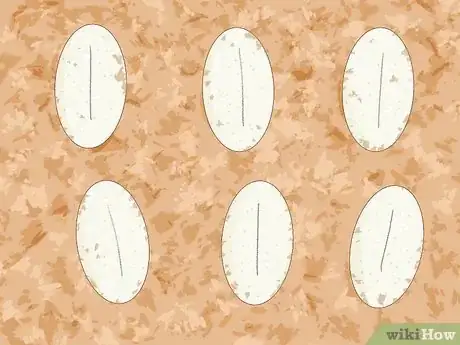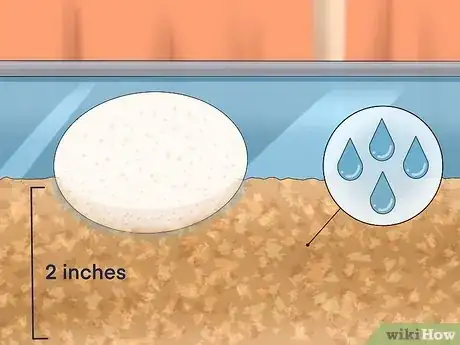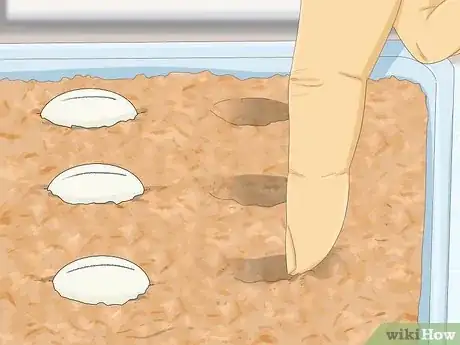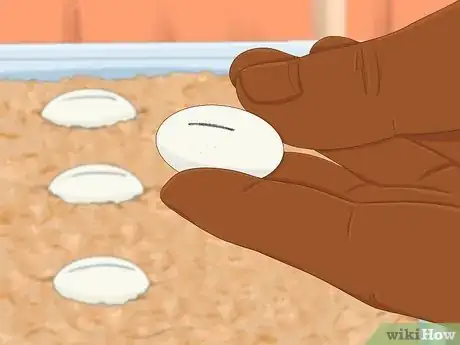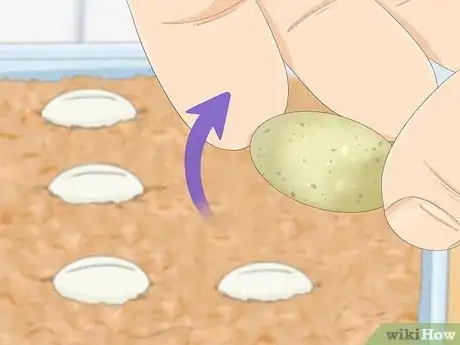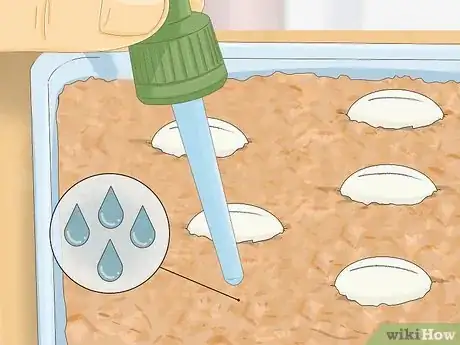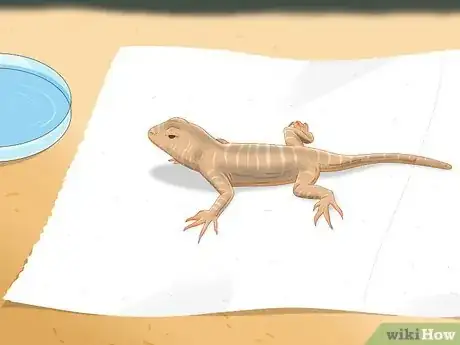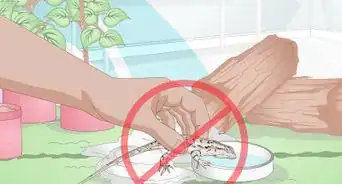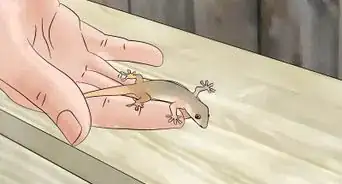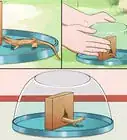This article was co-authored by Pippa Elliott, MRCVS. Dr. Elliott, BVMS, MRCVS is a veterinarian with over 30 years of experience in veterinary surgery and companion animal practice. She graduated from the University of Glasgow in 1987 with a degree in veterinary medicine and surgery. She has worked at the same animal clinic in her hometown for over 20 years.
wikiHow marks an article as reader-approved once it receives enough positive feedback. In this case, 80% of readers who voted found the article helpful, earning it our reader-approved status.
This article has been viewed 241,946 times.
You may have discovered a surprise in the form of newly laid eggs in your lizard's home, or maybe you decided to breed your lizards. Now that you have lizard eggs, you need to know how to take care of them to make sure they hatch properly. With some care and the right materials, lizard eggs are easy to care for. Set up an incubator, lay them on top of the proper substance, place the eggs in a container, and don't disturb them as you wait for them to hatch.
Steps
Setting up an Incubator
-
1Choose a container. The lizard that laid the eggs and the size of the eggs will determine what size container you use. Small eggs can be placed in deli cups or plastic containers. Medium-sized eggs can be placed in sandwich containers, and large eggs in larger plastic containers.[1]
- Cover the container with a lid that has holes poked in it for ventilation.
- Measure the container so you can choose an incubator large enough for your container.
-
2Purchase an incubator. Incubators are used to regulate the temperature as your eggs get ready to hatch. They should be insulated to keep a constant temperature and have clear sides or an easy way for you to watch the eggs. You can buy incubators at pet stores, farm supply stores, and online.[2]
- Make sure the incubator that you buy is large enough for your container of eggs. Make sure to measure the container before choosing an incubator.
- Hovabator incubators are inexpensive and used often by lizard pet owners. They work well for most species of lizard.
- Buying an incubator is probably the best option, especially if you are not experienced in hatching lizard eggs.
Advertisement -
3Make sure the thermometer is accurate. No matter if you have a commercial or homemade incubator, you should make sure that the thermometer works properly. You have to keep the incubator at a specific temperature, so you need to make sure it is accurate.[3]
- The exact temperature you have to keep the chamber will vary depending on the species. Research the particular species of lizard you have to make sure you keep it at the proper temperature. For example, most temperate and tropical species need around 80 to 85 degrees Fahrenheit (25 to 29 degrees Celsius).
-
4Make an incubator. If you don't have time or don't want to buy an incubator, you can make one. To do this, get a fish tank, an aquarium heater, two bricks, and plastic wrap.
- Place the bricks in the tank and fill it with water to just below the top of the bricks.
- Place the egg container on top of the bricks when you are ready to incubate.
- Put the aquarium heater in the water and set it to the correct temperature.
- Seal the top with plastic wrap to hold in the heat and humidity.
- You can also use a styrofoam cooler raised over a heating pad. Wait until the heating pad heats the styrofoam cooler to the right temperature, and then place your egg containers inside.[4]
- Make sure to measure the container you are going to use for your eggs before making an incubator. You want to make sure the container will fit into the incubator.
-
5Keep the eggs warm and protected if you cannot get an incubator. If there is no way for you to buy or make an incubator, you can leave the eggs where they are in the vivarium. First, look up to see if your species of lizard bury their eggs or leaves them in the open.[5]
- If they bury them, cover the eggs with a light layer of substrate. Stick a digital thermometer into the substrate next to the eggs.
- If your lizard leaves eggs out in the open, make a hole in a deli cup and place it over the eggs. Put a damp paper towel under the cup to keep the eggs from drying out.[6]
- In both cases, use heat lamps and pads to keep the temperature of the vivarium at the appropriate level for the species of lizard.
Placing the Eggs in the Incubator
-
1Mark the eggs with a pencil. Once you uncover the eggs, you should not turn them. Lizard eggs begin developing almost immediately and attach to the side of the egg. Use a pencil to gently mark the side of the egg facing you when you found it. This helps you remember the top of the egg so you don't damage the lizard inside. Sometimes the embryo inside can roll the egg.Put it the right way up immediately. However, an egg that has rolled over isn’t necessarily fatal to the embryo. [7]
- Moving them or rolling them to the other side can damage the embryo and kill the developing lizard.
-
2Separate the eggs. Some lizards will lay their eggs in a pile, which makes them stick together. If you find them early enough, you should carefully separate the eggs, trying not to damage the fragile shells. If they are stuck together, don't force them apart.[8]
- Separating the eggs help protect them. If one egg dies, mold or fungi from it can infect the healthy eggs. Although, a mouldy egg does not mean that the embryo inside has died. Sometimes mouldy eggs produce perfectly healthy reptiles.
-
3Choose an incubation medium that will retain water and remain sterile. The medium, or substance, that you place the eggs on inside the incubation tank is important. It should be able to retain water to help keep the incubator humid. It should be sterile or close to it, and it shouldn't promote growth of mold or fungi.[9]
- Perlite and vermiculite are common mediums that eggs can successfully incubate and hatch on. These mediums are very similar, and the choice is usually based on preference.
- You can find these substances at nurseries or home improvement stores with garden centers.
-
4Keep the medium moist. Incubation medium goes on the bottom of the container you're placing your eggs in. Place about one to two inches (25 to 50 mm) of the medium at the bottom of the container. It is important to keep the incubation medium moist while waiting for the eggs to hatch. Add water until the medium is barely clumping together. It should not be so wet that water drips out of it when it is squeezed.[10]
- Keep the medium at this moisture level until the eggs hatch.
-
5Make places in the medium for the eggs with your finger. Before you move the egg, make an indentation with your finger in the incubation medium where you want to put the egg. This gives the egg a secure place to lay so it won't roll around and hurt the embryo. This space also allows you to bury the egg slightly. The egg should be about half-covered with the medium.[11]
- Place multiple eggs about a fingers width apart from each other. Place the indentations in a line.
-
6Move the eggs into the container very carefully. When you are ready to move the eggs, use great care. First, make sure your hands are clean. Don't turn or roll the eggs around when moving them. Keep the top of the egg where you made a pencil mark facing up. Place them in the medium inside the container.[12]
- Don't let the eggs roll around when you move them.
- If the eggs are stuck on a branch, remove the branch and place it in the incubator. Do not try to remove the eggs from the branch because they will break. Cut the branch as small as possible without disturbing the eggs and try to find a container big enough for the branch too.
-
7Place the container in the incubator. Close the lid on the container containing the eggs. Then, place the container in the incubator. Write down the date of when the eggs were laid and placed in the incubator, calculate when they should hatch, and mark it on your calendar.
Monitoring the Eggs
-
1Monitor the temperature. During the incubation process, you should make sure the temperature stays regular. Maintaining the temperature is one of the most important things you can do to ensure that your eggs don't die.[13]
- Check the thermometer to make sure the temperature is not fluctuating inside of the incubator.
- Make sure to keep the medium damp if the temperature dries it out.
-
2Check the eggs regularly. Watching the eggs is important as you wait for them to hatch. Eggs may go bad and die at any point during the incubation process. Eggs may get too hot, too cold, wet, or dry and go bad.[14]
- Wet eggs may begin to grow mold, while dry eggs may start to collapse.
- Remove any bad eggs so they don't contaminate your healthy eggs.
-
3Adjust the conditions based on moisture level. If the eggs or medium are too wet, uncover the container. Leave it uncovered for a couple of days until the extra moisture evaporates. If the eggs are dry, add water to the medium. Do this slowly so you don't get everything too wet.[15]
- Never drop water directly onto the eggs. Drip water around the egg into the medium. Try using an eyedropper or a wet rag.
-
4Use a candling device to check the state of the eggs. You can buy a fiber optic candling device or small white LED light to check the eggs. Shine the light close to the egg, but be careful not to press on the egg or move it. The inside of the egg will glow. Healthy eggs should be pink and red with a few blood vessels inside.[16]
- If it glows yellow, either the egg is infertile, dead, or not enough time has passed to see growth yet.
- Eggs that are infertile or dead will turn an off-white or yellowish color and eventually grow mold or cave in.
-
5Set up the cages for the hatchlings. While you wait for your eggs to hatch, set up an enclosure for hatchlings. Make sure you have everything you need, including food. Most lizards will need to be put in small cages lined with paper towels in the first few weeks of life.
- Make sure the cage has the proper heat and humidity for babies. Babies will usually shed their first shed in 24 hours and you need to make sure it all comes off. Having the proper humidity will ensure you don't have shedding issues.
- Add a small water dish or get a misting bottle ready if the species only drink water droplets.
- Some babies require less heat than adults. Research specific heat requirements for babies of the species you have.
References
- ↑ http://www.reptilesmagazine.com/Breeding-Lizards/Leopard-Geckos-Tremper/
- ↑ https://www.lllreptile.com/articles/129-incubation-of-reptile-eggs/
- ↑ http://www.pethospitalpq.com/sites/site-3953/documents/Incubation%20of%20Reptile%20Eggs.pdf
- ↑ http://www.pethospitalpq.com/sites/site-3953/documents/Incubation%20of%20Reptile%20Eggs.pdf
- ↑ http://animals.mom.me/how-to-keep-lizard-eggs-alive-12534947.html
- ↑ http://www.geckotime.com/gecko-eggs-help/
- ↑ https://www.lllreptile.com/articles/129-incubation-of-reptile-eggs/
- ↑ https://www.lllreptile.com/articles/129-incubation-of-reptile-eggs/
- ↑ http://www.pethospitalpq.com/sites/site-3953/documents/Incubation%20of%20Reptile%20Eggs.pdf
- ↑ http://www.reptilesmagazine.com/Breeding-Lizards/Leopard-Geckos-Tremper/
- ↑ http://www.pethospitalpq.com/sites/site-3953/documents/Incubation%20of%20Reptile%20Eggs.pdf
- ↑ http://www.pethospitalpq.com/sites/site-3953/documents/Incubation%20of%20Reptile%20Eggs.pdf
- ↑ https://www.lllreptile.com/articles/129-incubation-of-reptile-eggs/
- ↑ https://www.lllreptile.com/articles/129-incubation-of-reptile-eggs/
- ↑ http://www.reptilesmagazine.com/Breeding-Lizards/Leopard-Geckos-Tremper/
- ↑ http://www.pethospitalpq.com/sites/site-3953/documents/Incubation%20of%20Reptile%20Eggs.pdf
About This Article
To take care of lizard eggs, start by looking up whether your species of lizard buries its eggs or leaves them out in the open. If it buries its eggs, cover the eggs with a light layer of substrate and insert a digital thermometer into the substrate so you can keep an eye on the temperature. If your lizard normally leaves its eggs out in the open, poke a hole in a plastic deli cup and cover the eggs with it. Also, put a damp paper towel under the cup so the eggs don't dry out. Whichever method you use, use heating pads and lamps to maintain the right temperature. To learn how to keep lizard eggs in an incubator, keep reading!
